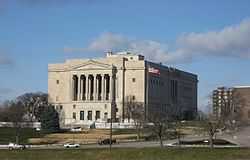Steele's Hill-Grafton Hill Historic District
|
Steele's Hill-Grafton Hill Historic District | |
 | |
|
The Dayton Masonic Center, a part of the district | |
 | |
| Location | Roughly bounded by Grand, Plymouth, Forest, and Salem, Dayton, Ohio |
|---|---|
| Coordinates | 39°45′59″N 84°12′15″W / 39.76639°N 84.20417°WCoordinates: 39°45′59″N 84°12′15″W / 39.76639°N 84.20417°W |
| Area | 70 acres (28 ha) |
| Built | 1880 |
| Architectural style | Classical Revival, Bungalow/Craftsman, Queen Anne |
| Governing body | Private |
| NRHP Reference # | 86001237[1] |
| Added to NRHP | June 5, 1986 |
The Steele's Hill-Grafton Hill Historic District, or simply known locally as Grafton Hill, is a small 18-block sector of Dayton, Ohio, United States that was developed in the late 19th century.
Historic district
In 1986, Steele's Hill-Grafton Hill was added to the National Register of Historic Places.[1] It is also a locally-designated historic district.[2]
History
Although sometimes considered part of Dayton View, Grafton Hill has its own separate and important existence and history. It was developed at a time when Dayton’s population was moving from the center of the city outward, north of the Miami River. Grafton Hill was enlarged and enriched in 1875 when John Stoddard, a wealthy and prominent farm implement manufacturer, developed the exclusive Belmonte Park residential area. The construction of the Dayton Art Institute and the Dayton Masonic Temple added to the affluent aura of the community. Today, Grafton Hill is known for the depth of it's economic and cultural diversity. The fashionable nature of Grafton Hill remains intact and continues to be celebrated.
Architecture
The architecture of Steele Hill-Grafton Hill Historic District include Jacobeathan style but also contains Queen Anne, Victorian, Craftsman, Classical Revival and Tudor style homes.
References
- ↑ 1.0 1.1 "National Register Information System". National Register of Historic Places. National Park Service. 2009-03-13.
- ↑ "City of Dayton - Historic District Map". Retrieved 5 October 2013.
External links
- Grafton Hill
- Dayton MostMetro on Grafton Hill
- Dayton Daily News article
- Old Grafton Hill Photos
- Preservation Dayton
| ||||||||||||||||||||||||||
| ||||||||||||||||||||||||||||||||||